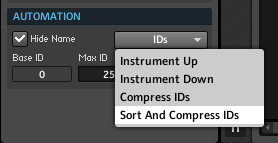Here’s a quick tip based on an issue I just helped someone with – when using Reaktor in Maschine, sometimes controls won’t be addressable by the knobs. What’s up with that? Usually, the knobs are mapped in pages to whatever controls are in your ensemble.
You might see something like this:
If that happens, in Reaktor, go to the properties for the instrument you want to map, go to the connect tab, and down at the bottom you’ll see something like this:
Right away we can see a big problem – Max ID is set WAAAAY lower than max ID in use. Here’s how to fix that. In the ID menu, choose “sort and compress IDs”. Then, change Max ID so it’s at least as high as Max ID in use.
You should end up with an arrangement like this:
If the Base ID of the instrument is not zero, which can happen if you have multiple instruments in an ensemble, use the “instrument down” command. Now when you look at the Maschine knob pages, you should see the names of the controls properly mapped, like so:
Note: this is not the same as MIDI mapping! Host automation, as we’re seeing in this example, doesn’t use MIDI CC numbers and MIDI channels. Instead, it uses a separate range of ID numbers.
By the way, I’ve noticed that a significant chunk of people are still using Reaktor 5.8 – thanks for answering the poll question – I will stick to that version for ensembles I’m currently authoring. Eventually we all have to be dragged kicking and screaming into the present, but for now – what do we say to the god of upgrading? Not today.











